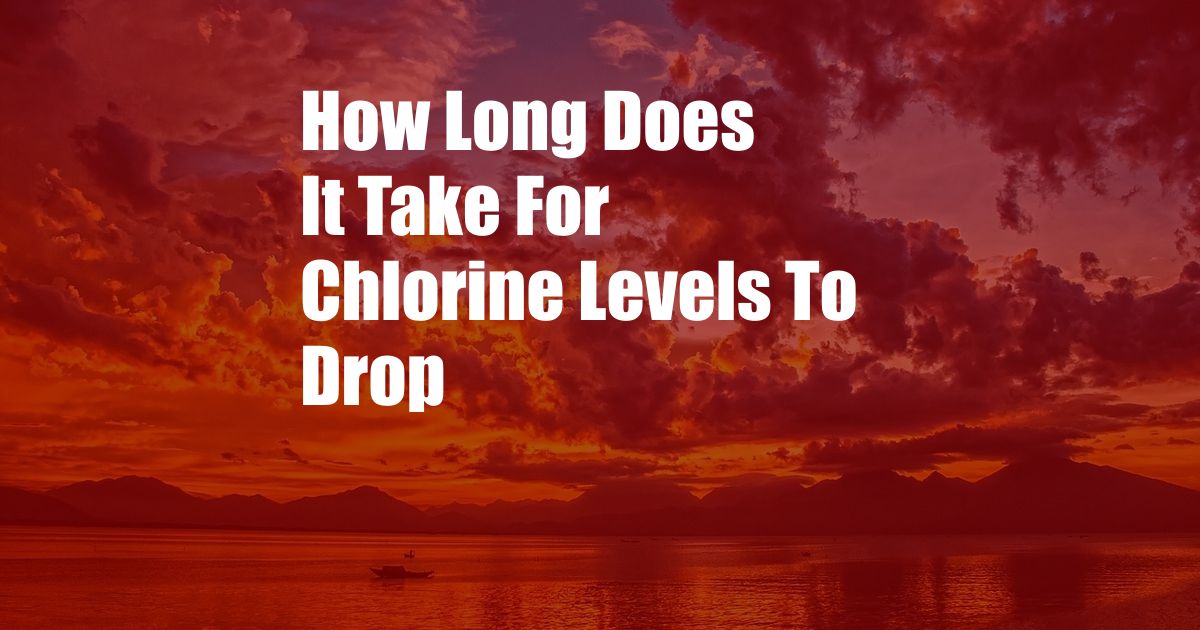
How Long Does it Take for Chlorine Levels to Drop?
As a homeowner with a swimming pool, maintaining the proper chlorine levels is crucial for ensuring the health and safety of swimmers. Chlorine effectively kills bacteria and other harmful microorganisms, but high levels can cause skin and eye irritation. Understanding how long it takes for chlorine levels to drop is essential for adjusting the chemical balance of your pool water.
Keep in mind that chlorine levels naturally decrease over time due to factors such as sunlight, swimmer activity, and organic matter. The rate at which chlorine dissipates depends on several variables, including the pool’s size, temperature, pH level, and the type of chlorine used.
Factors Affecting Chlorine Dissipation Rate
Pool Size: Larger pools require more chlorine to maintain the same level of sanitation. Hence, the chlorine depletion rate is typically slower in bigger pools.
Temperature: Chlorine decomposes faster at higher temperatures. Warmer pools experience a more rapid decline in chlorine levels than colder pools.
pH Level: The pH level of pool water influences chlorine’s effectiveness. Chlorine is more stable at lower pH levels (acidic), while it dissipates faster at higher pH levels (basic).
Chlorine Type: Different types of chlorine have varying lifespans. Cyanuric acid (stabilizer) can extend the lifespan of chlorine by protecting it from sunlight. Tablets and sticks typically have a longer lifespan than liquid chlorine.
How Long Does it Take for Chlorine Levels to Drop?
The time it takes for chlorine levels to drop significantly varies, but generally, you can expect the following:
- Unstabilized liquid chlorine: 1-3 days
- Stabilized liquid chlorine: 3-5 days
- Chlorine tablets or sticks: 1-2 weeks
It’s essential to test your pool water regularly using a reliable test kit to monitor chlorine levels. Aim for a chlorine concentration of 1-3 parts per million (ppm) for optimal sanitation.
Tips and Expert Advice
Regular Testing: Consistently check chlorine levels to ensure they remain within the recommended range.
Add Chlorine Gradually: Avoid over-chlorinating your pool. Add chlorine in small increments, testing the water after each addition.
Use a Pool Cover: Sunlight breaks down chlorine, so covering your pool when not in use can significantly extend chlorine’s lifespan.
Backwash Regularly: Remove contaminants from the filter by backwashing regularly. This helps prevent chlorine from being consumed by organic matter.
FAQ
Q: Why do chlorine levels drop faster in hot weather?
A: Chlorine decomposes more quickly at higher temperatures.
Q: Can I swim if chlorine levels are low?
A: Swimming in water with low chlorine levels can increase the risk of infection. It’s advisable to add chlorine or wait until levels return to a safe range.
Q: How often should I add chlorine to my pool?
A: The frequency depends on factors discussed above. As a general rule, test chlorine levels every 2-3 days and add chlorine as needed.
Conclusion
Understanding how long it takes for chlorine levels to drop empowers pool owners to maintain a balanced and safe pool environment. Remember, regular testing, proper usage, and expert advice are essential for ensuring optimal pool water quality. By following the tips and insights provided in this article, you can effectively manage chlorine levels and enjoy a clean and refreshing swimming experience.
Are you interested in learning more about pool maintenance and water chemistry? Explore our blog for additional resources and expert guidance.